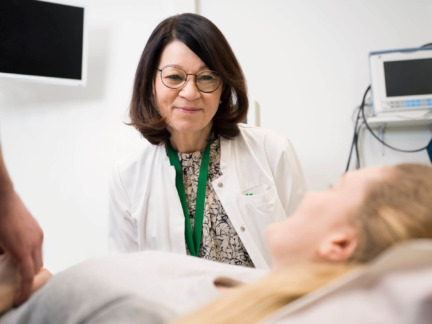Endometriosis
Endometriosis is a gynaecological disease that about 5–10% of women in reproductive age are diagnosed with. Its symptoms include menstrual pain, pain during intercourse and bleeding disorders and it can cause infertility. The majority of women with endometriosis can become pregnant without treatment, but endometriosis patients should seek infertility testing after six months of trying to conceive. Age and the severity of endometriosis impair the fertility of endometriosis patients.
Endometriosis is a chronic and benign gynaecological disease in which endometrium-like tissue is found outside the womb, causing a chronic inflammatory reaction. About 5–10% of women in reproductive age are diagnosed with the disease. The disease has a tendency to be hereditary; if there is a family history of endometriosis, the risk of the disease is multiplied. Endometriosis is an oestrogen-dependent disease and, therefore, it usually does not occur after menopause. The mechanism of the onset of the disease remains unclear.
Endometriosis may occur as:
- colonies on the surface of the peritoneum (peritoneal form)
- ovarian chocolate cysts (endometrioma)
- deep colonies between the vagina and the rectum (rectovaginal form), bladder, intestine and, less frequently, other organs.
Symptoms of endometriosis
The symptoms are diverse depending on where the endometriosis colonies occur. The oestrogen produced by the ovaries and endometriosis colonies maintains the disease and the associated inflammatory reaction of the abdominal cavity is the cause of pain and infertility.
Typical symptoms of endometriosis:
- menstrual pain that begins several days before the onset of bleeding
- bleeding disorders
- pain during intercourse and vibration
- urination and defecation pains during menstrual bleeding
- blood in the urine and feces during menstrual bleeding
- unspecific lower abdominal swelling and pain regardless of the phase of the menstrual cycle and
- infertility.
The symptoms can have a strong negative impact on the woman’s quality of life and endometriosis often causes fatigue and mood changes. On the other hand, the endometriosis findings and symptoms do not necessarily go hand in hand. One third of patients with endometriosis are asymptomatic.
Preliminary information as well as the results of a gynaecological examination and ultrasound scan can be used to study the disease. A normal gynaecological examination result does not exclude mild endometriosis. The most typical symptom related to endometriosis is tenderness in the area of the posterior broad ligaments of the uterus. Moving the uterus is painful and, in some cases, bluish endometriosis tissue can be seen at the base of the vagina. Superficial colonies are not visible in an ultrasound scan but ovarian chocolate cysts can be detected in both the bladder and intestine.
Treatment of endometriosis
There is no curative treatment for endometriosis and, therefore, the treatment methods are tailored based on the patient’s symptoms and findings. Endometriosis patients are treated for either pain or infertility. The treatment of both at the same time is challenging. The treatment of pain is based on the inhibition of the action of oestrogen in the endometriosis tissue. This can be done, for example, with a combination oral contraceptive pill, a minipill, a hormonal IUD or other hormonal medication that reduces oestrogen secretion. Surgical treatment is also possible if the pharmaceutical treatments do not help. There is no need to treat asymptomatic endometriosis.
Endometriosis and fertility
Endometriosis can affect female fertility by delaying pregnancy or causing infertility.
The effects of endometriosis on fertility are manifold:
- The endometrium of a woman with endometriosis may differ from that of a healthy woman.
- Chronic inflammation in the abdominal cavity maintains endometriosis.
- These factors can impair the quality of the egg cells and embryos, as well as impede the implantation of the embryo into the endometrium.
- Endometriosis has a peeling effect on the tissues and can cause adhesions to the female reproductive organs. These can alter the anatomy and interfere with the release of the egg as well as the passage of egg and sperm in the fallopian tube.
However, it is worth remembering that the vast majority of women with endometriosis become naturally pregnant without problems. If the pregnancy of a woman with endometriosis has not started after six months of attempts, it is advisable to seek examinations. Postponing having children to a later age increases the risk of infertility. The severity of endometriosis affects fertility. The more severe the disease, the more likely it is that infertility treatments are needed.
Endometriosis and infertility treatments
Before actual infertility treatments, symptomatic peritoneal endometriosis can also be treated surgically to improve the prognosis of pregnancy. Treatment decisions are always made according to underlying factors. The longer a pregnancy has been tried for and the older the woman is, the more active and effective is the chosen treatment line. The selection of the right form of treatment is also influenced by the result of the spouse’s sperm analysis.
If the pain caused by endometriosis is under control and the disease is mild, it is possible to proceed to insemination treatment, provided that the fallopian tubes are open and there are at most mild abnormalities in the sperm. If the disease is severe, the most effective form of treatment, i.e. in vitro fertilisation treatment, is started immediately.
Infertility treatments are always tailored individually, taking into account all aspects that affect the outcome of treatment.
